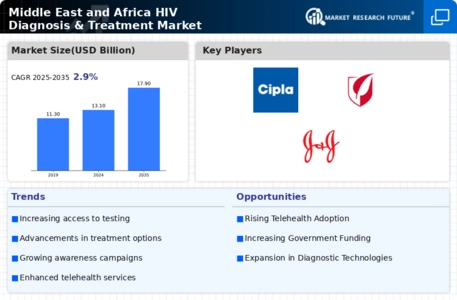Market Share
HIV Diagnosis Treatment Market Share Analysis
In a dynamic landscape of HIV Diagnosis & Treatment Market, companies use different positioning strategies to gain market share and contribute to global efforts in the fight against HIV/AIDS. One common method involves using technological changes to create new diagnostic tools and treatment options. Therefore, investments in research and development are directed towards introducing products that are effective but also user friendly thereby meeting diverse markets globally. In addition, this innovation not only helps a company grow its market share but also solidify its position as a key player in the sector.
Another crucial strategy revolves around geographical extension and market entry. Companies target areas with high prevalence rates due to high global HIV/AIDS prevalence. This is achieved through partnering with local health institutions, governments, non-governmental organizations among other key players in order to enhance availability and access of diagnostic and treatment solutions. Depending on geographical location, firms can take advantage of specific needs for their products thereby building market share across diverse regions.
Collaboration and strategic alliances also play crucial roles in market positioning within the HIV Diagnosis & Treatment sector. Corporations usually team up with academic institutions including medical schools; industry partners like pharmaceutical companies or even governmental organizations so as to pull together resources, competencies as well as hasten breakthroughs on cutting-edge solutions. With such collaborations comes an all-inclusive approach towards diagnostic/treatment platforms including establishment of norms which guide the industry practices today. By taking collaborative initiatives forward, firms can achieve considerable market share growth while promoting a cooperative environment that is beneficial for everybody within the sector.
Additionally, pricing approaches are vital aspects when establishing company positions in the HIV Diagnosis & Treatment Market by share volume. They must employ flexible pricing schemes that strike a balance between being affordable yet profitable at the same time. This is especially important where there is limited health care infrastructure thus requiring cost-effective alternatives that can reach many more patients than expensive ones would do. Such moves includes adopting tiered prices alongside discounts initiated through strategic partnerships with hospitals and clinics among others which would enable the company to grow its clientele base while making sure that they can cater for the needs of different people in the market.
Another strategy that is crucial for positioning of market share is through emphasis on education and awareness campaigns. This involves investing in initiatives that not only promote their products, but also enlighten healthcare providers as well as general public about significance of early discoveries and proper treatment of individuals with HIV/AIDS. These campaigns are for reducing stigma, raising testing rates, and improving overall disease control. Companies that employ this tactic become advocates for public health; thereby contributing to a common goal as well as cementing their place within the industry by building a good brand image.”






Leave a Comment